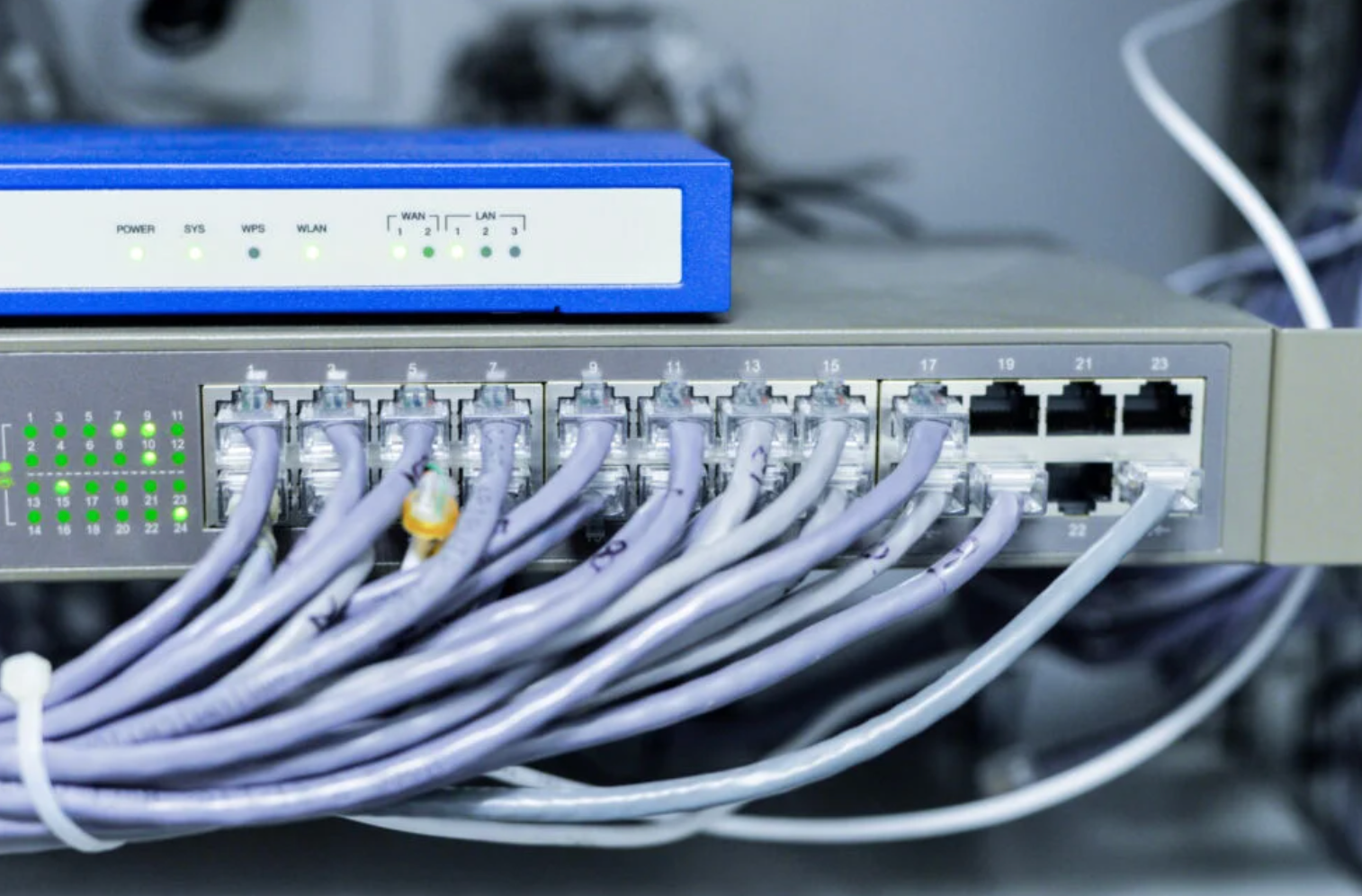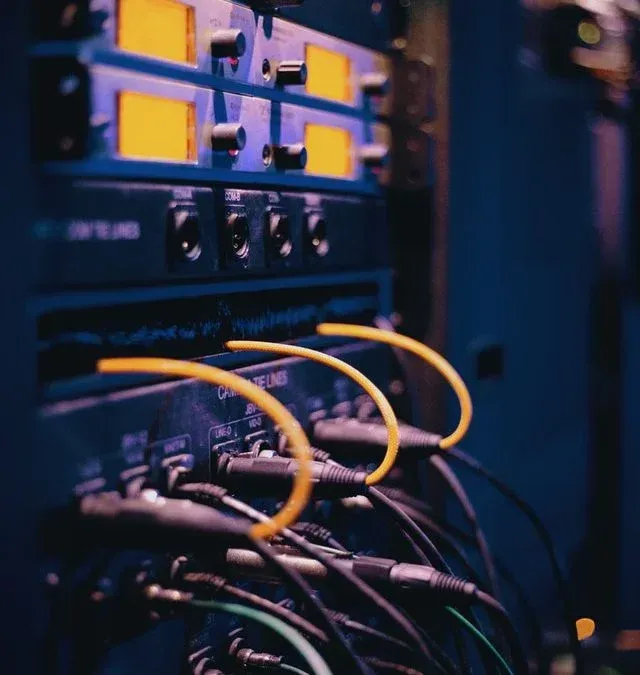Blog
Straight Line Communications can provide the structured cabling solutions you need to operate a successful business

In the digital age, cloud computing has become the cornerstone of modern IT infrastructure, revolutionizing how businesses store, manage, and access data and applications. Behind the seamless connectivity and rapid scalability of the cloud lies a critical component often overlooked: structured cabling. In this blog post, we'll explore how structured cabling serves as the backbone of cloud architecture and why it's essential for ensuring the reliability, performance, and scalability of cloud-based services. The Foundation of Cloud Connectivity Structured cabling forms the foundation upon which cloud architecture is built. At its core, the cloud relies on data centers—large facilities housing thousands of servers, storage devices, and networking equipment—to store and process vast amounts of data. These data centers require a robust and organized network infrastructure to interconnect servers, storage arrays, switches, and other critical components. Structured cabling provides the physical layer that enables seamless communication and data transfer within data centers and across the cloud. Reliability and Redundancy In the cloud, reliability is paramount. Downtime can have significant consequences, affecting productivity, revenue, and customer satisfaction. Structured cabling plays a crucial role in ensuring the reliability of cloud services by providing redundant paths for data transmission and minimizing the risk of network disruptions. By employing redundant cabling pathways, switches, and connections, structured cabling enhances fault tolerance and ensures continuous operation even in the event of hardware failures or maintenance activities. Scalability and Flexibility One of the defining characteristics of the cloud is its ability to scale dynamically to meet changing demands. Whether it's adding new servers, expanding storage capacity, or provisioning additional network bandwidth, cloud infrastructure must be able to scale seamlessly to accommodate growth. Structured cabling facilitates this scalability by providing a flexible and modular network infrastructure that can easily adapt to evolving requirements. With proper planning and design, structured cabling enables data centers to scale up or down quickly and cost-effectively without disrupting operations. High-Speed Connectivity In the cloud, data must flow quickly and efficiently between servers, storage devices, and end-users. Structured cabling ensures high-speed connectivity by deploying high-performance cables, connectors, and switches capable of supporting gigabit and multi-gigabit data rates. By minimizing signal degradation, electromagnetic interference, and latency, structured cabling helps maximize network performance and deliver a seamless user experience across the cloud. Simplified Management and Maintenance Managing and maintaining a sprawling cloud infrastructure can be challenging without a well-organized network infrastructure in place. Structured cabling simplifies management and maintenance by providing a clear and structured framework for identifying, tracing, and troubleshooting network connections. With properly labeled cables, organized patch panels, and documented cabling configurations, IT personnel can quickly diagnose and resolve issues, reducing downtime and optimizing system performance. Conclusion In conclusion, structured cabling serves as the backbone of cloud architecture, providing the foundation for reliable, scalable, and high-performance cloud services. By ensuring reliability, redundancy, scalability, and flexibility, structured cabling enables data centers to deliver seamless connectivity and exceptional performance to users worldwide. As businesses continue to embrace the cloud for their IT needs, structured cabling will remain a critical component for driving innovation, efficiency, and success in the digital era.

In the dynamic landscape of modern business infrastructure, the symbiotic relationship between virtualization and structured cabling plays a pivotal role in shaping efficiency, scalability, and adaptability. Virtualization, the process of creating virtual instances of servers, storage devices, networks, and applications, revolutionizes how IT resources are utilized and managed. On the other hand, structured cabling forms the backbone of connectivity within organizations, ensuring seamless data transmission and communication. Together, they form a powerful alliance that empowers businesses to thrive in the digital era. Understanding Virtualization Virtualization is the cornerstone of modern IT infrastructure, enabling organizations to maximize resource utilization, enhance flexibility, and streamline operations. By abstracting physical hardware and creating virtual representations, virtualization decouples software from hardware, allowing multiple virtual instances to run on a single physical machine. This technology encompasses various forms, including server virtualization, network virtualization, storage virtualization, and desktop virtualization, each offering unique benefits tailored to specific organizational needs. The Crucial Role of Cabling Infrastructure Structured cabling serves as the foundation for reliable and efficient communication networks within organizations. Unlike traditional point-to-point cabling systems, structured cabling organizes and standardizes the arrangement of cables and connectivity components, facilitating easier management, scalability, and troubleshooting. It encompasses a comprehensive system of cables, connectors, patch panels, and related hardware, meticulously designed and installed to support data, voice, and multimedia services. The Synergy Unveiled Optimized Connectivity: Structured cabling provides the physical infrastructure required to interconnect virtualized resources. Whether it’s linking servers in a data center or connecting endpoints in a virtual desktop environment, structured cabling ensures seamless and reliable connectivity, minimizing latency and maximizing throughput. Scalability and Flexibility: Virtualization empowers organizations to scale IT resources dynamically based on evolving demands. Structured cabling complements this scalability by offering a flexible infrastructure that can accommodate changes and expansions without disruptive rewiring or reconfigurations. Modular components and standardized practices enable swift adjustments to meet evolving business needs. Enhanced Reliability and Performance: A robust cabling infrastructure system enhances the reliability and performance of virtualized environments. By minimizing signal degradation, electromagnetic interference, and crosstalk, structured cabling ensures consistent data transmission and reduces the risk of downtime. This reliability is essential for mission-critical applications and services hosted on virtualized platforms. Streamlined Management and Maintenance: Virtualization centralizes the management of IT resources, simplifying administration and reducing operational overhead. Structured cabling complements this efficiency by providing a clear and organized infrastructure that facilitates easier maintenance, troubleshooting, and upgrades. Proper labeling, documentation, and cable management practices streamline tasks for IT personnel, promoting productivity and agility. Future-Proofing Infrastructure: As organizations embrace digital transformation and adopt emerging technologies, the synergy between virtualization and structured cabling becomes increasingly vital. By investing in a robust cabling infrastructure designed to accommodate future technologies and higher bandwidth requirements, businesses can future-proof their IT infrastructure and adapt to evolving trends with minimal disruptions. Conclusion In the ever-evolving landscape of IT infrastructure, virtualization, and structured cabling stand as pillars of innovation and efficiency. Their synergy empowers organizations to harness the full potential of virtualized environments while ensuring robust connectivity, reliability, and scalability. By recognizing the intrinsic relationship between these technologies and investing in their integration, businesses can lay a solid foundation for success in the digital era. We are leaders when it comes cabling infrastructure . Contact us today at 732-952-2800 to learn more about our services!

Moving to a new office can be challenging, but planning ahead will ensure the process is smooth and stress-free. This is the ideal time to upgrade your networking infrastructure and install structured cabling, which is a very important element of your internet connectivity. Moving offices will provide you with the perfect opportunity to ensure your new office is well-equipped to handle high bandwidth of data while making sure it’s scalable for new users. Data & Infrastructure The usage of internet data for businesses is growing significantly every year, and it is a must that you have an understanding of future data usage and users. To do this successfully, you will need a highly sustainable and scalable network cabling infrastructure; talking to a structured cabling company is the first step. Experts from a reputable structured cabling company will guide you through the processes and will help you build an optimal cabling network for optimal communications performance. If your office is completely new, the cable and conduits must be roughed in before the walls are done. Cables can be installed and terminated within specific wall locations before your new office furniture arrives. Some cables that terminate into modular furniture can only be routed out to the floor during these early stages, for later configuration with your new office furniture and equipment. Evaluating Wireless Coverage Make sure you evaluate the new office’s Wi-Fi coverage, and you can complete a wireless survey if necessary to avoid potential dead spots. Always document your Wi-Fi coverage expectations, and the use of Fibre optic is a must for all new-age internet services. Assess your budget to determine whether you can consider fiber cabling, which can run to strategic points in your server room. The capacity of fiber is far greater than that of copper, and having it installed during your initial cabling project will usually cost less than having it installed after your move. If your budget allows for it, structured cabling companies will highly recommend this option. Plan Your Server Room Don’t forget to plan your server room design to accommodate future updates, and remember that this area needs to be as open as possible. It should also be well-ventilated and dust-free, and you must invest in proper and reliable door security to restrict access to your server room. Office security is extremely important, and this aspect must be prioritized along with data cabling. You need to make sure all important areas are covered with high-resolution CCTV cameras capable of streaming live videos on any network device, including mobile phones; this needs to be carried out before you move in. Proper wiring for cameras is very important, and this step needs to be planned before the move into the new office is complete. Your Tech Experts for Office Relocation Here at Straight Line Communications, we have years of experience with office moves and offer a number of services, including voice and data cabling, data room build-outs, warehouse cabling, and Wi-Fi heat mapping. We are leaders when it comes to structured cabling and specialize in cabling infrastructure and NDAA security cameras. Contact us today at 732-952-2800 to learn more about our services!

Office design, layout, and style vary and reflect a business’s overall brand image. Often, commercial security ranks lower on the list of office layout priorities, but it’s absolutely crucial to business security, comfort, and image. Although commercial security requirements and needs can range based on each company, there are certain security techniques that are crucial to ensure the safety of all office spaces. In this article, Straight Line Communications reflects on how to effectively design your company’s office layout to ensure safety and security. 1. Ensure Secure Lock Systems Office buildings are highly populated and frequented during business hours. This can leave your office space vulnerable to intruder access. That’s why ensuring your office is highly secure and protected should be your company’s prerogative. Access to the office should be relatively easy and straightforward for business partners and employees to ensure safe evacuation planning as well. Many companies choose to have a master key lock system installed to secure the office space and only allow access to verifiable employees. 2. Video Surveillance To Safeguard Business Property It goes without saying that video security equipment should absolutely be a vital part of commercial security. Having the master lock key system functioning is not enough protection for an entire SMB. Video security equipment such as security camera options in New Jersey can prevent and reduce the likelihood of theft of your business property. Once a potential thief sees the video security camera, there’s a high possibility that they’ll be deterred. Video surveillance also protects your company from threats to employees or business partners. If your company faces some form of threat or accusation, you can count on our video security equipment to capture a dispute or accident, and verify or challenge it with tangible proof. 3. Protect Boardrooms With an AV System One of the most used and important rooms in an office is the boardroom. Any SMBs can benefit from having an audio and visual system installed to easily communicate with other business partners or clients at any time. AV systems are user-friendly, highly advanced, and can be either remotely or centrally administered. Many AV units are far more secure than IP systems, for example, fiber optic AV system cables offer more advanced security than copper cables. 4. Safe Call Centers Part of creating a safe and secure office layout is to establish or ensure a safe call center. This likely involves a reliable business phone system for smooth communication, which can increase business sales, promote good customer service and reduce overall costs. At Straight Line Communications, we work with all varieties of SMBs to find and install the best phone system for your business. Straight Line Communications technicians specialize in installing premium video security equipment, business phone systems, fiber optic cabling solutions, structured cabling solutions, and other security camera products in New Jersey. With over 40 years of combined experience, we are highly proficient in the services we offer and every project we work on. Get started with us today for the ultimate security solutions with a FREE quote at https://slcnj.com/contact-us/.

Does your commercial building, apartment, or business have the infrastructure to handle the complex demands of telecommunication? A structured telecommunications cabling system can help you connect and communicate more easily and efficiently. What is Structured Cabling? Structured cabling is about building an organized cabling infrastructure and associated hardware that involves a number of structured smaller components to provide a comprehensive telecommunications infrastructure. The infrastructure needs to be properly designed to serve a wide range of high-performance uses for telephone services or data transmission requirements through a computer network. The structured cabling system has a series of patch panels and trunks that allow hardware ports to connect. Simply explained, the system starts at the point where the service provider (SP) ends, called the point of demarcation or Network Interface Device (NID). A telephone system, for instance, is installed with one or more service lines per customer by service providers (SP). These service lines are connected at the point of demarcation. Why are Structured Cabling Systems Important Each structured cabling system is unique to meet the unique demands of different building constructions. The types of cabling equipment and installation need to support the architecture, configure with the existing installed system, plus support both present and future installations. It needs to meet customer requirements and offer proper manufacturing warranties. The cabling service must be a responsible company that ensures proper installation to ensure system performance from the complex arrangements. You may have heard of LAN (Local Area Network), MAN (Metropolitan Area Network), and WAN (Wide Area Network). These are industry terms for network installations. The ones for small areas of structured cabling installation serving a building typically need to include the entrance, vertical and horizontal backbone pathways, backbone cables, horizontal pathways and cables, work areas, equipment rooms, telecommunications closets, and multi-user telecommunications outlet assemblies, among others. Entrance facilities are of four types: underground, buried, tunnel, and aerial (overhead). Aerial entrances cost the least and are easiest to maintain but come in the way of traffic and pedestrians, traffic, can damage the building exterior or face damage in wind and ice. They are jointly installed with power companies, telephone or data service providers, and CATV companies. Backbone cabling is when the structured cabling network branches out to other buildings from the entrance, as well as within the building from floor to floor, which is why it gets its name. They interconnect the main cross-connects, telecommunications closets, equipment rooms, and entrance facilities in the cabling system structure (intrabuilding) as well as the cabling between buildings (interbuilding). Backbone cabling has a shorter life expectancy of three to ten years. A good connection is also dependent on cabling connectors among other components. A connector is a mechanical device that connects a cable to a piece of equipment or connects one cable to another. There are several more complex components to the cabling system that need to work in a structured manner to facilitate high-quality telecommunication services. Organized structured cabling needs to be quick, effective, and aesthetic. The risks of not switching to a structured cabling system include a messy cabling infrastructure that leads to channel errors in the hardware that is difficult to resolve, among other complexities. With a structured cabling system, wiring in data centers, apartment buildings, and voice communications centers allows seamless communications more effectively. Straight Line Communications, New Jersey Contact Straight Line Communications in New Jersey to install a structured data cabling system by trained and certified personnel. We offer superior service and a workmanship warranty. Browse our website for more information.

